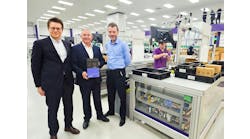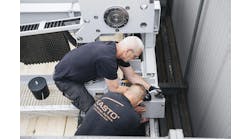Jim Montague is the executive editor for Control, Control Design and Industrial Networking. Email him at [email protected].
Motors and electronic drives have gone thorough many evolutions in recent years, but these advances in networking, integration, intelligence, diagnostics and analysis have a common purpose — to improve end users' machines and applications. Five or six years ago, for example, electronic drives for industrial servo systems began to move out of their control cabinets to get closer to their motors, according to Reid Hunt, product manager for drives and controls at Kollmorgen.
"Especially on long or big machines with multiple cabinets and cables, it can save time and hardware and improve reliability to have an integrated motor and drive," Hunt explains. "However, while physically combining can make it hard to exhaust heat and maintain performance, integrating them with a hybrid cable can solve this problem. We just launched a decentralized servo system that links drive and motor with an eight-wire, 11-mm-diameter, composite cable that can be 0.5 to 5 m long, and lets us mount a drive close to its motor on the same machine chassis. A second, 11-mm cable lets drives be daisy-chained and run motion buses such as EtherCAT via power wiring."
SEE ALSO: Advances in Technology Spur New Look at Drives and Motors
Not surprisingly, these increasingly sophisticated ties between drives and motors are accompanied by leaps in intelligence as well. Evan Kaiser, business team lead for compact drives at Rockwell Automation, reports that drives are getting smarter to perform more sophisticated control, operating and communications tasks. "In the past 10 years, drives added devices and architectures that ease commissioning, improve diagnostics and put software building blocks at users' fingertips to give them predictive, post-event maintenance and safety functions," Kaiser says. "This means they can trend live output current from a drive, see bearing problems earlier, find issues sooner in a motor control center managing hundreds of drives, or use the safety circuits in a drive to replace contactors. Previously, you'd need an external sensor for jobs like these, but now many drives do them automatically, and we can monitor many signatures and trends for our customers."
Following the transition from dc to ac drives over the past 20 years, variable-frequency drive (VFD) and servo users now seek drives that can deliver customized physical and power matches for their applications, according to Craig Nelson, product manager for Sinamics drives at Siemens Industry.
"More customers want the value of only paying for what they need for the application at hand, but they also require flexibility for their machine designs to keep up with fast-paced trends, and so they apply servos and more axes in decentralized approaches with drives and devices right on motors and machines instead of in centralized cabinets," Nelson explains. "However, these decentralized drives require protection from the environment, so in January, we added our S120M decentralized motor integrated drives to our S120 centralized drive system. S120M reduces cabinet size by integrating the inverter with the servomotor on the machine, and then uses a hybrid cable to reduce multiple cable runs between the cabinet and the machine. For example, if a machine expands from four to six axes, a machine builder can add them to the end of a hybrid cable's daisy chain without worrying about added cable runs and if they'll fit in a cabinet."
Beyond meeting technological and economic needs, digital servo drives also can reduce energy costs and meet green and sustainable manufacturing efforts, adds Robert Swalley, motors and drives product specialist engineer at Beckhoff Automation. "As a result, we're also selling more servo amplifiers and terminals, such as our EL7201 servo terminal that we introduced in 2011. It slides into an I/O rack, and can combine with our AM8100 servomotor to run at approximately 200 Watts. Also, it serves in applications that require smaller motors and amplifiers, which in turn cuts more costs.
To futher reduce expenses, Swalley confirms that drives and motors are using One-Cable Technologies (OCT) that combine power and communication in one cable. Beckhoff's larger capacity servo amplifier can operate with one-cable servomotors or traditional two-cable motors. In addition, its I/O modules, terminals, servos and other components are integrated into TwinCAT automation software. "This means users' drive configurations are all taken care of in software," Swalley adds. "This is a big advantage because use of servomotors and drives are going to continuously increase over the next few years."






